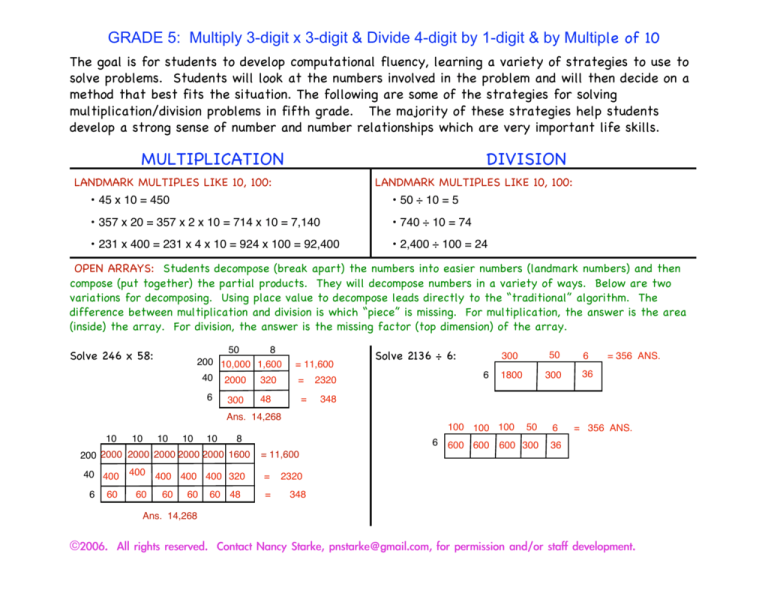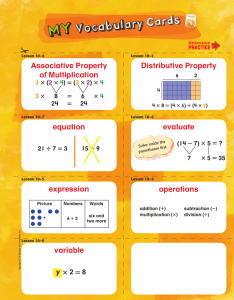
GRADE 5: Multiply 3-digit x 3-digit & Divide 4-digit by 1-digit & by Multiple of 10
The goal is for students to develop computational fluency, learning a variety of strategies to use to
solve problems. Students will look at the numbers involved in the problem and will then decide on a
method that best fits the situation. The following are some of the strategies for solving
multiplication/division problems in fifth grade. The majority of these strategies help students
develop a strong sense of number and number relationships which are very important life skills.
MULTIPLICATION
DIVISION
LANDMARK MULTIPLES LIKE 10, 100:
LANDMARK MULTIPLES LIKE 10, 100:
• 45 x 10 = 450
• 50 ÷ 10 = 5
• 357 x 20 = 357 x 2 x 10 = 714 x 10 = 7,140
• 740 ÷ 10 = 74
• 231 x 400 = 231 x 4 x 10 = 924 x 100 = 92,400
• 2,400 ÷ 100 = 24
OPEN ARRAYS: Students decompose (break apart) the numbers into easier numbers (landmark numbers) and then
compose (put together) the partial products. They will decompose numbers in a variety of ways. Below are two
variations for decomposing. Using place value to decompose leads directly to the “traditional” algorithm. The
difference between multiplication and division is which “piece” is missing. For multiplication, the answer is the area
(inside) the array. For division, the answer is the missing factor (top dimension) of the array.
50
8
200 10,000 1,600
40 2000 320
Solve 246 x 58:
6
300
= 11,600
=
2320
=
348
48
Solve 2136 ÷ 6:
6
300
50
6
1800
300
36
= 356 ANS.
Ans. 14,268
100 100 100
10
10
10
10
10
8
200 2000 2000 2000 2000 2000 1600
40 400
6
60
400 400 400 400 320
60
60
60
60 48
6
= 11,600
=
=
50
600 600 600 300
6
= 356 ANS.
36
2320
348
Ans. 14,268
©2006. All rights reserved. Contact Nancy Starke, pnstarke@gmail.com, for permission and/or staff development.
MULTIPLICATION
CLUSTERS: Decomposing numbers to make simpler
simpler problems. Very similar to open arrays without box.
Solve 246 x 58:
246 x 50 = 12,300
246 x 8 = 1,968
14,268
DIVISION
MODIFIED TRADITIONAL: Long division using the whole
dividend for each step.
6’s
356 r 1
Solve 2,137 ÷ 6:
6
2137
300
- 1800
337
- 300
37
- 36
1
50
6
TRADITIONAL ALGORITHM: Uses place value to
compute the product. Placement of the digits is key
to finding the partial products. Using the open array and
decomposing (breaking apart) using place value leads
directly to this method.
TRADITIONAL ALGORITHM: Relies on placement of digits
to compute the quotient. DMSB (divide, multiply, subtract,
bring down).
356
LATTICE: An algorithm dating back to the 1200’s
relying on basic facts and addition. Create the correct
size grid. Solve the individual facts for each box inside
the corresponding dimensions. Add up the digits within
a diagonal. Does not require number sense.
SHORT METHOD: A method relying more on mental
math than the long division algorithm above. Divide six
into 21. That is 3 but there will be three left. Place those
3 with the next digit (place) and divide again. Requires
some number sense and is much easier than long division.
6 2136
18
33
30
36
36
246
x 58
1968
1230
14,268
2
1
1
1
4
2
0
6
4
2
0
3
2
6
6
3
4
0 5
356
6
2 13336
8 8
8
These strategies are developed in the following unit(s) in our curriculum:
• Mathematical Thinking, Building on Numbers You Know.
©2006. All rights reserved. Contact Nancy Starke, pnstarke@gmail.com, for permission and/or staff development.







